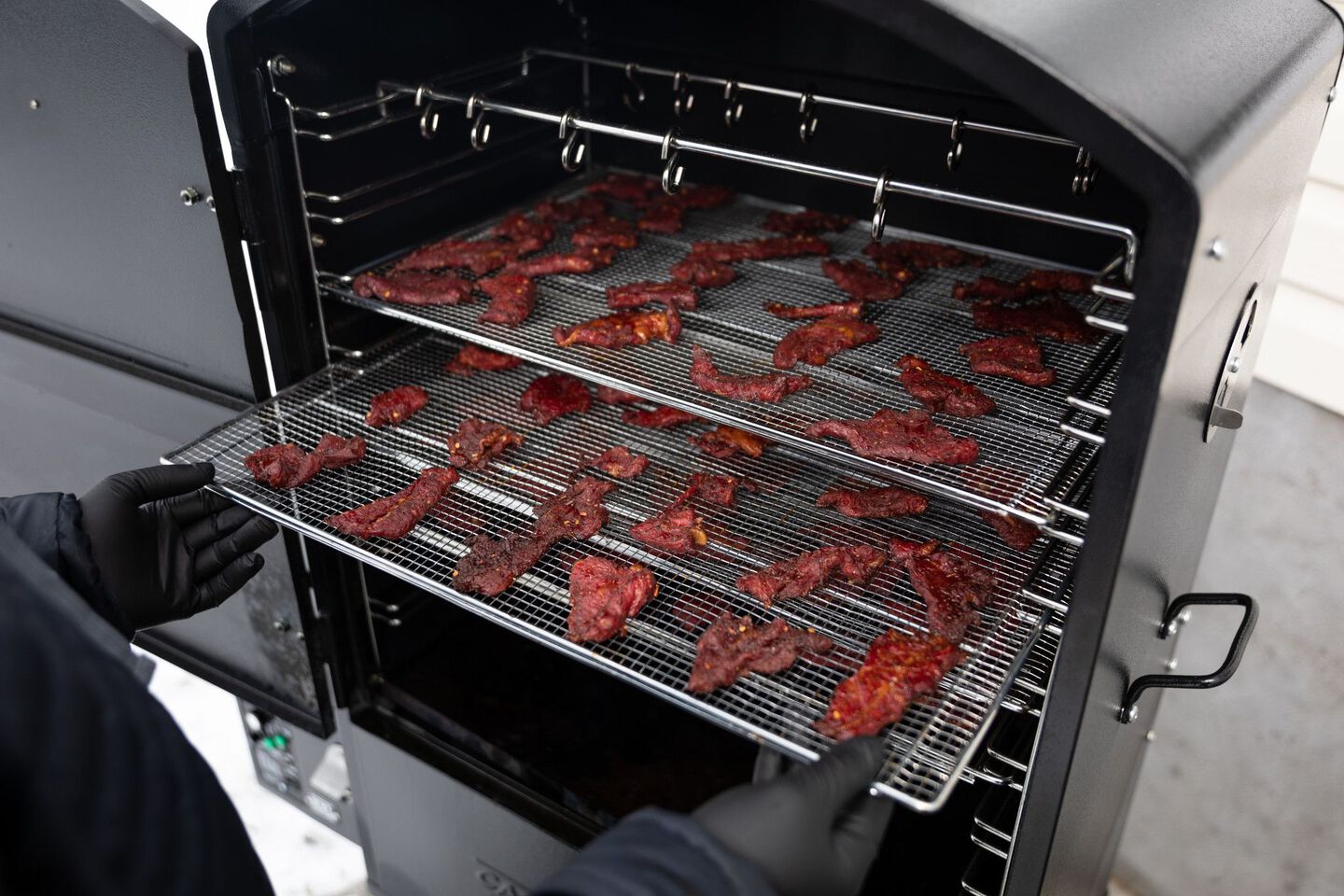
Homemade Smoked Jerky

prep
15 min

cook
2 hrs

feeds
3-5
If you do nothing else on your smoke vault or pellet grill, you have to make a batch of homemade jerky. Seriously. It's easy, delicious, and loads cheaper than buying a bag of mystery-ingredient jerky you'll find at the gas station. Store-bought jerky, generally speaking, has much more sugar and salt than what you need in homemade jerky. Control what goes in your food while still enjoying incredible jerky flavor with this recipe. Note: This recipe works great with your typical beef, as well as wild game like deer and elk.
The practice of smoking meat to preserve it has been used for thousands of years by many cultures around the world. The exact history of smoking jerky is unclear, but it is believed to have originated with indigenous peoples in the Americas, who dried strips of meat in the sun or over open fires to preserve it for later consumption.
Smoking jerky as a method of preservation was particularly useful for nomadic cultures, who could pack dried meat strips for long journeys and hunting trips, where fresh meat was not always available. As these cultures came into contact with European settlers, the practice of smoking meat spread, and jerky became a staple food item for pioneers and settlers on their westward journeys.
In the 20th century, jerky production became industrialized, and the dried meat snack became widely available in grocery stores. Today, jerky is made from a variety of meats, including beef, pork, and game meat, and is often flavored with spices and seasonings. Despite the rise of more modern preservation methods, jerky remains a popular snack for its unique flavor and long shelf life.
Smoked jerky has a distinct, smoky flavor that comes from the smoking process. The smoke imparts a rich, woodsy flavor that can be further enhanced by the addition of spices, seasonings, and marinades. The texture of jerky is also unique, as it is typically dried and chewy, which can make it a satisfying and flavorful snack.
The taste of jerky can vary depending on the type of meat used and the specific recipe, but it is generally described as being savory, with a slightly salty taste. Beef jerky is one of the most common varieties and is known for its rich, meaty flavor, while turkey jerky is lighter and milder in taste. Jerky made from game meats, such as venison, can have a more earthy flavor, and the addition of spices and seasonings can make for a wide range of flavor profiles.
Overall, smoked jerky is a delicious and flavorful snack that is popular for its unique taste and texture. Whether you prefer it spicy, sweet, or somewhere in between, there's a jerky out there to suit every taste.
Here are some tips for smoking jerky that can help you achieve delicious results:
Choose the right meat: Lean cuts of beef, venison, or turkey are ideal for making jerky, as they have a low fat content and will dry evenly during the smoking process.
Marinate the meat: Marinating the meat in a mixture of seasonings, spices, and liquid (such as Worcestershire sauce or soy sauce) for several hours or overnight. This will add flavor to the jerky and help keep it moist.
Cut the meat correctly: Cut the meat against the grain into thin strips, about 1/4 inch thick, for the best texture.
Dry the meat: Before smoking, dry the meat strips with paper towels to remove any excess marinade and allow the smoke to penetrate evenly.
Smoke at the right temperature: Smoke the jerky at low head until it reaches an internal temperature of 160°F. This will help to kill any bacteria and prevent spoilage.
Use the right wood: Different types of wood will impart different flavors, so choose the wood that best complements the flavor of the meat you're using. For example, hickory is a classic choice for beef jerky, while apple wood is great for turkey.
Smoke for the right amount of time: The smoking time will depend on the thickness of the meat and the desired texture, but generally, jerky should be smoked for 4-6 hours.
Store the jerky properly: Once the jerky is finished smoking, let it cool completely and then store it in an airtight container in a cool, dry place.
By following these tips, you should be able to produce delicious, high-quality jerky that is perfect for snacking or as a portable, high-protein food source.
Ingredients
2 pounds eye of round roast, sliced to 1/4
(Keep in mind that jerky shrinks up quite a bit, so a 2 lb. piece of meat will get you about a pound of jerky.)
3/4 cups Worcestershire sauce
3/4 cups soy sauce
1 tablespoon honey
2 tablespoons coarse ground black pepper
1 teaspoon garlic salt
1 teaspoon onion powder
1 teaspoon curing salt
Instructions
Homemade Smoked Jerky
Step 1
Start by getting eye of round roast; it's a great combination of muscle and marbled fat. Most good butcher shops will slice the roasts for you if you tell them you're making jerky.
Step 2
You can slice the meat yourself into 1/4-inch thick slabs for thicker jerky or 1/8-inch thick slabs for thinner jerky. Try to be as consistent as possible so you can cook all your jerky for the same amount of time. You don't want to overcook super thin pieces while you're waiting for thick pieces to finish. From there, slice the slabs into strips, preferably against the grain (this makes it easier to eat).
Step 3
Next, combine all ingredients besides the meat in a mixing bowl.
Step 4
Seal the bag and massage the meat until all the slices are evenly coated. Refrigerate for at least 4 hours. It's not a bad idea to take the bag out on occasion to knead or mix the meat and marinade around.
Step 5
After a good chill, take the meat strips out of the bag and lay them on a couple of jerky racks so none of the slices are touching. Place them around the center of the racks so no pieces get overcooked on the edges. You can sprinkle extra pepper or seasonings on at this point if you'd like.
Step 6
Heat your smoker or pellet grill to 225°F, and smoke the jerky for 2 - 2 1/2 hours.
Step 7
When the jerky is done, it will be dark in color and tough to the touch. You can use the "Bend Test" to make sure each piece is finished: try bending one piece of jerky in half; the piece shouldn't break or fray, but it shouldn't feel flimsy. If your jerky is somewhere in that sweet spot between brittle and flexible, it's ready.









